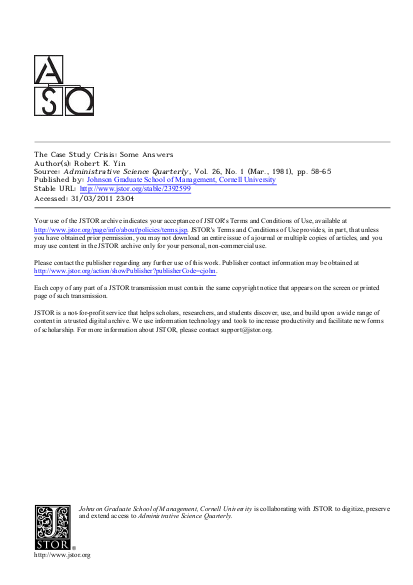
In hisASQ article entitled "Qualitative data as an attractive nuisance," Matthew Miles (1 979) has written a disarmingly candid rendition of the perils of qualitative analysis. Unfortunately, his candor in admitting the existence of these perils was matched by few suggestions for overcoming them. As a result, his article, based on a four-year study of six public schools, leaves the readerwith a sense that qualitative analysis-and its implicit companion, the case study - cannot yet be regarded a rational, much less scientific venture. Miles' principal problems were that: (a) within-case analysis was "essentially intuitive, primitive, and unmanageable" (1979: 597), (b) cross-case analysis was "even less well formulated than within-site analysis" (1 979: 599), and (c) respondents objected to case study results much more frequently than to survey results, either threatening the research team with legal suit or attempting to rewrite history in order to appear more favorably in the case study (1 979: 597). In conclusion, Miles states that, without renewed efforts at methodological inquiry, "qualitative research on organizations cannot be expected to transcend story-telling" (1 979: 600).
The Miles article cannot be taken lightly. A well-respected researcher, frequently cited for one of the earliest contributions to the study of organizational innovation, Miles (1 964) has indicated that there are grave problems with our craft. Furthermore, he leaves little hope for the immediate future, because the needed methodological research could require a decade or two (or three). Under these circumstances, what are the students of case study research to think? Indeed, what are the funders of social science research to think as they review new proposals for case studies? If Miles is correct, why should there be any further support for case studies as a research and development activity? These are the questions that raise the spectre of a case study crisis, and these are the questions that require some answers.
The purpose of this reply is to reaffirm the role of the case study as a systematic research tool. Although major improvements in case study research are still to be made, the goal is to show that an acceptable craft has already emerged.
New to the Third Edition are: additional examples of case study research; discussions of developments in related methods, including randomized field trials and computer-assisted coding techniques; added coverage of the strengths of multiple-case studies, case study screening, and the case study as a part of larger multi-method studies, and five major analytic techniques, including the use of logic models to guide analysis. This edition also includes references to examples of actual case studies in the companion volume Applications of Case Study Research, Second Edition (Sage, 2003).